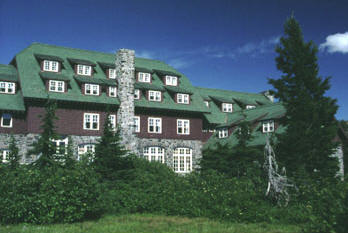Historic Resources at Crater Lake National Park
Description
Crater Lake Lodge
Name: Historic Resources at Crater Lake National Park
Location: Crater Lake National Park, Oregon
Classification: Buildings and District, public (Federal)
Function or Use: Recreation and Culture/Outdoor Recreation, Landsape/park, Domestic/hotel, secondary structure, Government/Office
Areas of Significance: Landscape Architecture (1916-1942), Architecture (1909-1942), Conservation (Development of Crater Lake NP) (1902-1942)
Builder/Architect: National Park Service (Charles Punchard, Jr., Thomas Vint, Merel Sager, Francis Lange)
Dates: 1927-1941
National Register listing of eighteen buildings as the Munson Valley Historic District at Park Headquarters and four other structures near the rim of Crater Lake followed from submittal of a multiple property form in 1988. It was based on recommendations contained in a National Park Service historic resource study and an associated building inventory conducted in 1984, both of which emphasized the significance and integrity of the park’s rustic architecture. Consequently, boundaries around Crater Lake Lodge, Sinnott Memorial, Comfort Station #68, and Comfort Station #72 included only the immediate area around each structure. In 1990 the NPS completed a cultural landscape report for Rim Village, a document which identified and evaluated features associated with planning and design efforts in the district between 1927 and 1941. [1] The purpose of this amendment is to describe those features and relate them to the historic contexts of park development and rustic architecture established on the original form. Boundaries given on the original form are revised accordingly to consolidate previously listed properties at Rim Village into a historic district that includes associated designed landscape features. A minor deletion to the Munson Valley Historic District is also necessary due to erroneous location information on the original form; the adjusted boundaries are described in Section 10.
Rim Village Historic District
Situated on the southern edge of a caldera partly filled by Crater Lake, the district averages 7,100 feet in elevation and is primarily linear, in that it closely follows the rim for just under one half mile. Rim Village is centered around a paved road which runs east from a junction with the West Rim Drive to its terminus in front of Crater Lake Lodge. The associated landscape is a mixture of highly designed and developed areas, along with less disturbed indigenous forest consisting of Mountain hemlock (Tsuga mertensiana), and Shasta red fir (Abies magnifica var. shastensis). Naturalistic in appearance, the district’s structures and landscape features clearly reflect National Park Service master plans of the 1930s which emphasized overall visual consistency and subordination to the surroundings. Extensive use of stone masonry is a unifying characteristic within Rim Village, much as it is in the Munson Valley Historic District, but historic plantings consisting of native vegetation and defined circulation systems are more extensive. In functional terms, Rim Village remains the focal point for visitor services at Crater Lake National Park. Food service, hiking trails, interpretive programs, strolling on the promenade, and enjoying views of the lake provide visitors with both passive and active opportunities for education and recreation. No other site in the park provides such a diversity of uses in one place.


